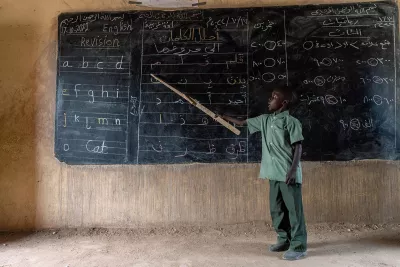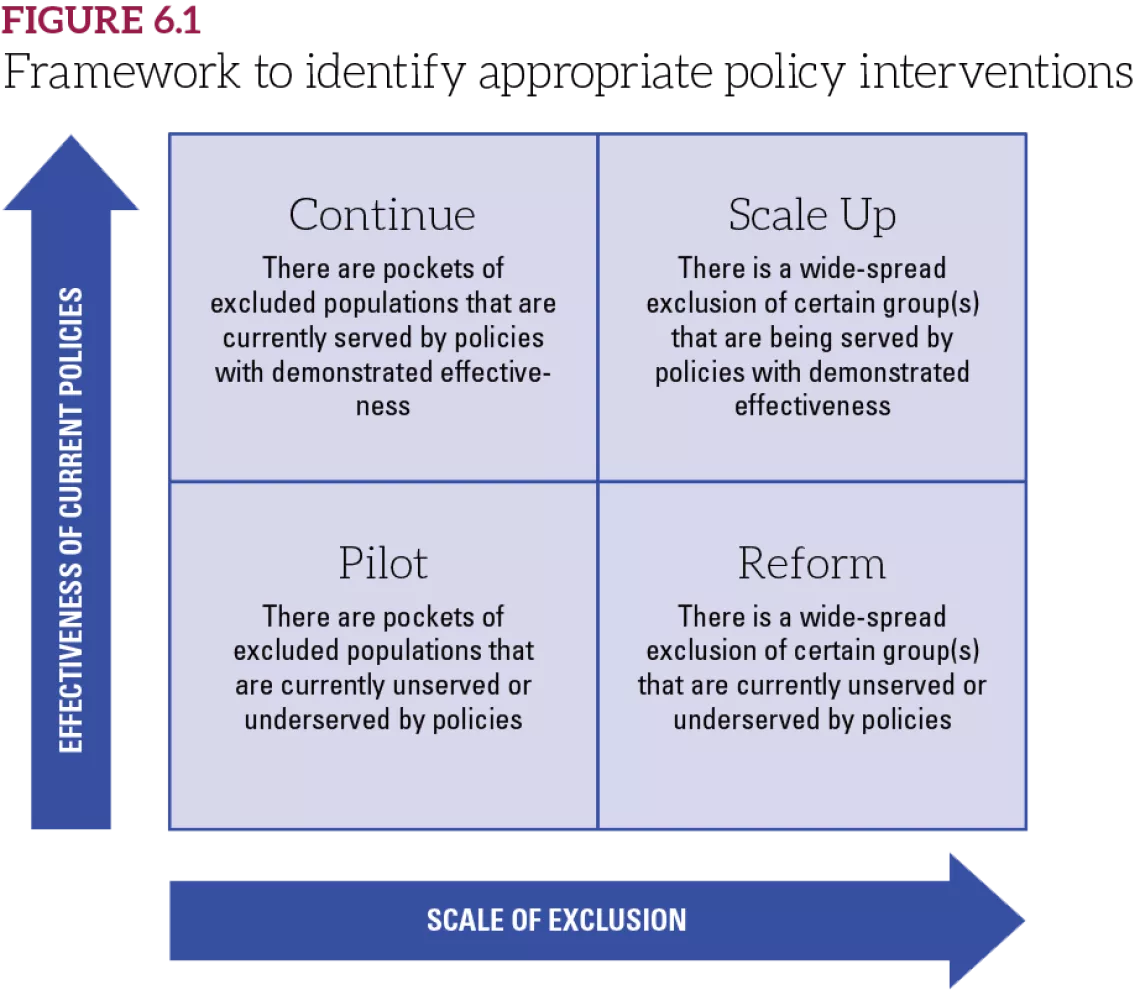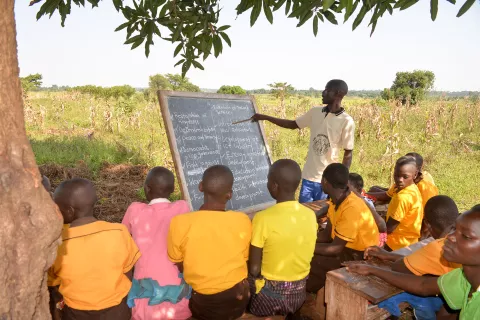OOSCI Operational Manual: Policy and strategy recommendations
Translating the findings of previous analysis into effective action

The policy recommendations in the OOSCI report must be accompanied by plausible arguments to prioritize the proposed actions over other options.
This section of the OOSCI Operational Manual includes guidance for choosing the policies and associated recommendations to support children, adolescents and youth in the seven dimensions of exclusion (7DE). It provides suggestions for writing and structuring the policies chapter of an OOSCI study.
The purpose of the policies chapter is to help translate the findings of the previous analysis into effective action: identifying relevant policy options and strategies which can reduce or eliminate the barriers to education faced by the key groups of out-of-school children and children at risk of dropping out.
 Identify and assess existing relevant policies
Identify and assess existing relevant policies

It is important to explore options for changes in government policy that could eliminate or significantly diminish critical barriers to education. The OOSCI formative review and the meta-analysis highlighted that the analysis of existing policy has been a weak spot in some out-of-school children studies.
A first step to the formulation of policy recommendations should be an analytical policy analysis. This review of existing policy should critically examine the relevance, efficiency and effectiveness of adopted measures, beneficiary focus, implementation capacity at the central, sub-national and school levels, and impact of the existing policies, to provide a clear evidence-basis for prioritized policy recommendations. The review should also recognize the efforts made by the country and identify the key policies and programmes that can be the entry points.
Drawing on the priority barriers to education, many of the most relevant policy options may be within the education sector. Key education policies to review include those within current education strategic plans (ESPs), and/or those relating to compulsory education, ‘free’ education, school access, promotion and repetition, inclusive education, remedial and out-of-school support and national examinations.
However, the desk review should not limit itself to education policies only. As the reasons for being out of school are multi-dimensional, the policies which influence school enrolment cut across sectors.
Other possible policy areas with impacts on education access and retention are:
- Social protection
- Labour or economic policy
- Statistical and civil registry policy
- Child protection policy
- Health policy
- Anti-discrimination policy
-
Gender equality/empowerment of women
The key questions to analyse each of the policies may include:
- Who are the main intended beneficiaries of the policy?
- What kind of barriers have been identified and addressed in the policy?
- Does the policy include efforts to address social and behavioural barriers to enable inclusive education?
- What are the achievements of the policy? Was there any unintended effect of the policy?
- How was the progress monitored?
- Were the interventions relevant to address the barriers?
- To what extent the representatives of the targeted beneficiaries were involved in the design, monitoring, and implementation of the policy?
- What was the cost associated with the policy implementation? Was the policy adequately funded?
- Was there enough capacity for the policy implementation?
- To what extent was a shared understanding of the policy developed by designers and by those education actors at the sub-national level who are tasked to implement it?
How these policies interact with other national policies, such as the country’s decentralization framework (governing who is responsible for what, and with what resources) should be considered. Considering how these policies affect the key profiles of children in the 7DE is important, the assessment should be gender- and disability-sensitive.
It can also be instructive to identify promising practices from other countries that reduced education exclusion for similar barriers and profiles of children in the 7DE. Several global reports summarize the available research on effective education programmes for improving access. It is important to note that such policies from abroad should be adapted to the national context, notably through discussion with national experts and piloting in country.
The desk review can be complemented and/or triangulated with additional qualitative information. The information may be collected through interviews with national policy experts, OOSCI partners and/or focus group discussions with school heads, teachers, families and adolescents who can provide critical perspectives on their experiences with the policy and the most relevant ways to address barriers.
The policy review should identify data and evidence gaps that limit the study team’s understanding of existing policy reach and effectiveness, and ultimately, evidence-based policy making.
Policies can be categorized according to the MoRES framework, which enables the policies to be linked to the critical barriers.
For more detailed information on identifying and assessing existing relevant policies, please view Section 6.1 of the OOSCI Operational Manual.
 Develop the policy recommendations
Develop the policy recommendations

Policy recommendations are typically written up as high level recommendations and are prioritized by explaining how these changes may reduce or eliminate barriers to education for the key profiles of children in the 7DE.
Ideally, policy recommendations should be systemic, so that they can target multiple barriers or profiles of children in the 7DE at the same time.
The policy review should have identified the areas for policy improvement. Depending on the scale of exclusion and the effectiveness of the existing policies, the recommended intervention may vary.
Figure 6. 1 depicts a useful framework for OOSCI study teams to consider when determining policy recommendations.

Policy recommendations may also indicate the level of urgency (immediate, medium or long-term), cost implications (no, low, high) and responsibility lines for each of the proposed strategies and actions.
Policy and strategy recommendations can target barriers in the enabling environment, demand, supply and/or quality.
The policy options generated in the previous review should then be refined into a concise set of feasible policy recommendations that would make a substantial and sustainable reduction in the number of children out of school. These proposed policy changes should address the most critical barriers to education identified in the previous section, and the key profiles of children in the 7DE.
Policy decisions and associated resource allocations are about trade-offs between sectors (e.g., education and health) and within the sector (e.g., basic education and technical/ vocational education). The policy recommendations in the OOSCI report must be accompanied by plausible arguments to prioritize the proposed actions over other options.
For more detail on developing and prioritizing policy recommendations, view Section 6.2 of the OOSCI Operational Manual.
 Link the findings of the study together: profiles, barriers and policy recommendations
Link the findings of the study together: profiles, barriers and policy recommendations

Once the policy recommendations have been drafted, discussed amongst key stakeholders and prioritized, they can be written up as a narrative in the OOSCI study policy chapter. The review of existing policies and proposed policy changes should link to the profiles and barriers analysis.
The goal of the policy chapter is to present an evidence-based argument in favour of a select set of policy changes, which once implemented, should significantly reduce the number of out-of-school children and children at risk of dropping out in the country.
The MoRES framework and barriers can be used as a framework to organize and present the policy review and recommendations.
The study team can consult other regional and country OOSCI studies for ideas on how to organize and streamline the recommendations. For example, the Latin America and the Caribbean regional OOSCI study grouped policy recommendations into broad areas and specified the relevant barriers, proposed actions and which dimensions of exclusion would be the most impacted. Furthermore, the Palestine OOSCI study grouped barriers in part based on their actionability, and organized policy recommendations according to their ease of implementation (quick fixes, bolstering existing efforts, mainstreaming, new programmes).
Download the OOSCI Operational Manual to view a sample matrix (see Table 6.1) that shows how the critical barriers, profiles affected, the assessment of existing policies, and the policy recommendations are brought together.
 Plan the next steps: implementation of recommendations
Plan the next steps: implementation of recommendations

Plans to ensure the OOSCI study has impact should be developed before the study begins. Considerations include identifying the goals of the OOSCI study process, developing a communication and capacity-building strategy for key actors, and identifying in advance of all the channels and fora to which the OOSCI study findings and recommendations will contribute (including Education Sector Plans, joint sector reviews, education sector annual work plans, donor and UN agency programming cycles). This ensures that the OOSCI study findings are used in regular policy and funding processes. How this looks will vary for each country, depending on the findings, the various stakeholders and policy windows.
To build on the momentum of the OOSCI study launch, a working action plan can be developed to outline the next steps. This not a standalone out-of-school children policy, but a working action plan to concretely identify how the recommendations, research gaps, and capacity building needs identified in the study will be discussed and taken forward by actors or agencies. This includes the inclusion of OOSCI study findings in key policy and decision-making moments (e.g., new Education Sector Plan, new annual Ministry of Education Budget), and development partner funding and programme cycles.
To support the finalization and launch of an OOSCI study, a number of new tools have been developed for study teams. These include a Powerpoint template for developing a policy workshop, as well as social media card templates to share study-related events and products.
See section 6.5 of the OOSCI Operational Manual to read three in-depth case studies of how countries undertook the OOSCI study process (or adaptation of OOSCI methodology) from conceptualization to policy impact, to illustrate how the policy recommendations can move from words to action.




